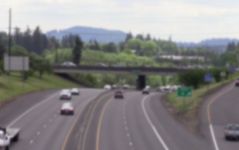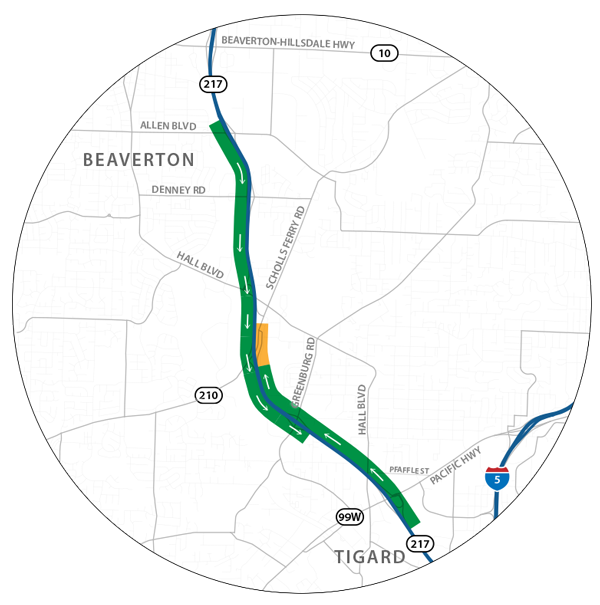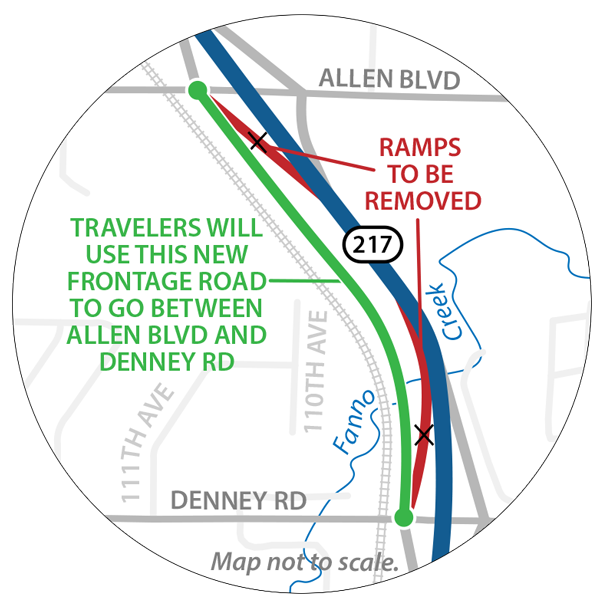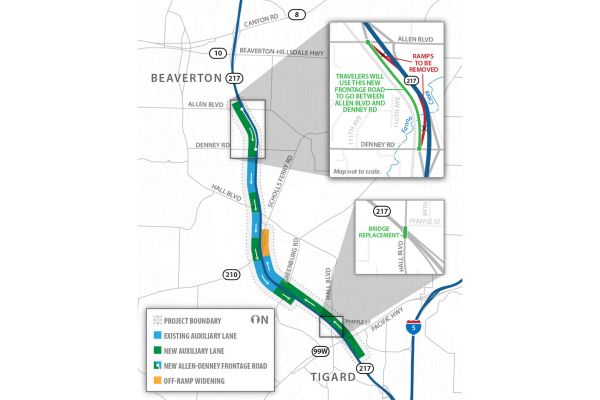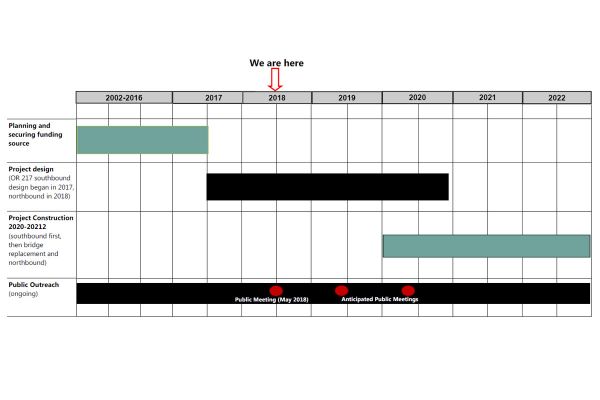You may go directly to a station using the buttons below, or click the Get Started button at the top of the screen to move through the stations in order.
Additional Information
Stations
Why is this project needed?
OR 217 carries up to 120,000 vehicles a day, with 10 interchanges in just over seven miles of highway and some of the shortest interchange spacing in the region. Road users experience significant bottlenecks, leading to high crash rates and more congestion.
ODOT has been studying lower cost, effective ways to mitigate bottlenecks, and building auxiliary lanes was identified as a means to improve safety and operations on the highway.
These improvements are not intended to address capacity-related congestion, but rather to provide immediate and long-term safety improvements at bottleneck locations.
The Oregon Legislature allocated $98 million toward this project in House Bill 2017.
Solutions
Auxiliary lanes are designed to separate the slower vehicles entering or exiting the highway from the higher speed vehicles continuing to drive along the highway. They are built either from one interchange to the next, or span several interchanges.
In addition to new auxiliary lanes, the project will also:
- Add a new frontage road between the Allen Boulevard and Denney Road interchanges along OR 217 southbound;
- Widen the Scholls Ferry off-ramp from OR 217; and
- Replace the southernmost Hall Blvd bridge over OR 217 to accomodate the new auxiliary lanes.
Benefits
Local and regional traffic on OR 217 will benefit most from the auxiliary lane extension. Only 10% to 15% of the trips on OR 217 go from one end to the other. The other 85% to 90% of trips use one or more of the interchanges along OR 217. The auxiliary lanes will separate slower traffic movements from the freeway, helping smooth traffic flow, reduce the potential for crashes and improve traffic reliability. Overall, this will improve the regional economy by facilitating the movement of goods and services.
Additionally, the new frontage road at the Allen Boulevard and Denney Road interchanges will remove the extremely short weaving section that is one of the worst bottlenecks on OR 217 and has a high frequency of crashes. This road will also provide a place for existing traffic to wait to access cross streets, rather than backing up onto the highway.
(Click "Next" to learn more about these project elements.)
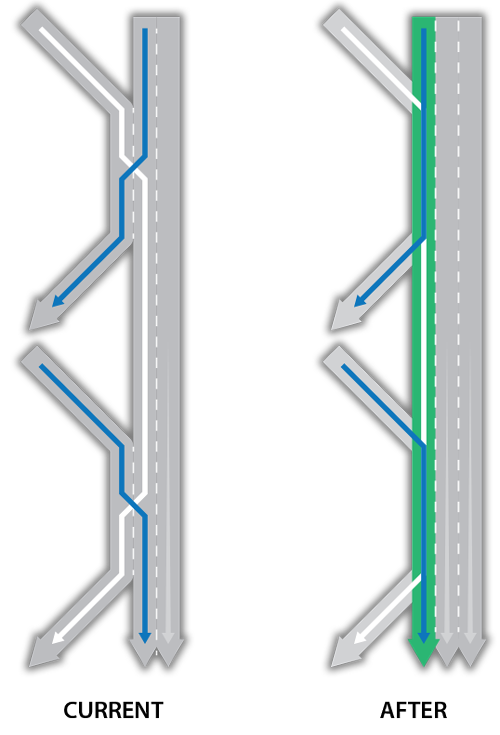
Auxiliary lanes reduce conflict, improve traffic reliability and allow for more stable flow of traffic at interchanges. Ultimately, fewer crashes are expected as the weaving and merging occurs in a separate lane from the rest of the highway.
The new auxiliary lanes on OR 217 will be on the right side of the highway and will span several interchanges before ultimately ending at an off-ramp.
Auxiliary Lanes
New lane improvements will help reduce recurring bottlenecks and allow for more stable traffic flow at the OR 217 interchanges.
Southbound lane improvements include:
- An auxiliary lane from Beaverton-Hillsdale Highway that will connect with an existing auxiliary lane at OR 99W. Drivers will use this auxiliary/right lane for getting on and off the highway. Those driving straight through on OR 217 will have two full lanes to travel in, separate from the on- and off-ramp merging traffic
Northbound lane improvements include:
- An auxiliary lane from OR 99W to Scholls Ferry Road. Drivers will use this auxiliary/right lane for getting on and off the highway. Those driving straight through on OR 217 will have two full lanes to travel in, separate from the on- and off-ramp merging traffic.
- An additional lane on the Scholls Ferry Road off-ramp.
Both northbound and southbound improvements will incorporate new retaining walls, as well as wider highway shoulders that will allow stalled vehicles to move out of traffic and emergency vehicles to quickly respond.
Frontage Road at Allen & Denney
A new frontage/connector road will be constructed between Allen Boulevard and Denney Road in the southbound direction. This will remove the extremely short weaving section that is one of the worst bottlenecks on OR 217 and has a high frequency of crashes.
Once the frontage road is built, the southbound Allen Boulevard on-ramp and the southbound Denney Road off-ramp will be removed. Drivers who currently use these ramps will use the new frontage road instead. A new bridge over Fanno Creek will be built to carry the frontage road traffic over the creek.
Bridge at Hall Boulevard
The Hall Boulevard overpass (at SW Pfaffle Street) will be replaced to accommodate the new auxiliary lanes. Once complete, the bridge will be the same width and height.
The bridge replacement is expected in 2021 and will be constructed half at a time. All road users on Hall Boulevard in this section will travel over half a bridge for several months. The bridge will remain open, but people should expect delays and congestion throughout construction.
Noise Mitigation Study
ODOT is in the midst of a noise study to determine the feasibility of noise walls along OR 217. Several factors determine sound wall feasibility including cost, how many homes will benefit from a wall and how much of a decibel reduction a wall would provide. All of those are factored into the final decision.
The final results are not yet known, and will be shared when complete. The study should be ready for public release in summer or fall 2018.
If a noise wall is recommended by the study, we will work closely with adjacent neighbors throughout design and construction.
Neighbors will hear nighttime construction intermittently throughout construction.
Construction Impacts
During construction, all existing lanes of OR 217 will remain open during weekday daytime hours. Work that could impact travelers will be primarily performed during nights and weekends to minimize traffic impacts. People can expect traffic delays, detours, noise and intermittent ramp closures. Traffic impacts are also expected on some local streets.
While the Hall Boulevard bridge is replaced, half the bridge will remain open at a time allowing continued use for people driving, walking or bicycling.
ODOT will be seeking a noise variance from the City of Beaverton and the City of Tigard to conduct the nighttime work. ODOT will work closely with neighbors and the contractor to minimize noise impacts as much as possible.
Additional Information
Stay Involved
ODOT will continue to share information with local businesses and residents, neighborhood groups, on the project website and at future public meetings. We encourage you to continue to learn about the project, ask questions and share your feedback.
There are several ways to stay involved:
- Submit feedback using the form below.
- Visit the project website: hwy217.org
- Sign up for the project mailing list to recieve regular updates
- Attend future public meetings.
- Share information with friends, family, neighbors and coworkers.
- Contact: Lili Boicourt, ODOT Community Affairs Coordinator
Phone: 503-731-8247 | Email: Lili.D.Boicourt@odot.state.or.us
Give us Feedback
Take the short survey below to tell us your hopes and concerns for the project.

